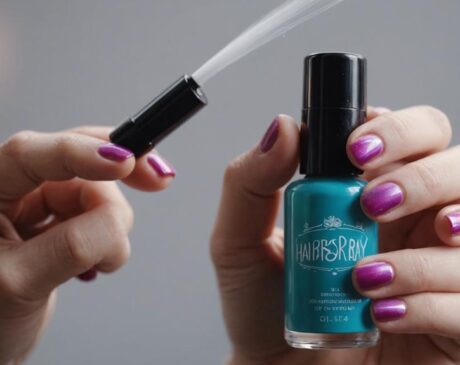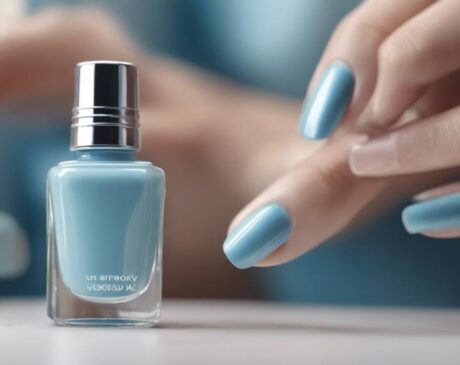What Happens if You Wear Nail Polish All the Time?

Continuously wearing nail polish can cause issues like discoloration, weakened nails, higher susceptibility to fungus, allergic reactions, and chemical exposure risks. To prevent damage, use hydrating products, give nails breaks, apply quality base coats, and opt for gentle removers. Maintaining nail health involves hydration, nutrition, avoiding harsh chemicals, and moisturizing. It's crucial to be mindful of these effects to keep your nails in top condition. Further insights on addressing and preventing these concerns are available in the detailed research provided.
Key Takeaways
- Discoloration and staining can occur from nail polish pigments seeping into nails.
- Weak and brittle nails may result from prolonged use of nail polish.
- Increased risk of nail fungus due to excessive moisture from polish.
- Allergic reactions, from mild irritation to severe symptoms, can develop over time.
- Concerns about chemical exposure and potential health risks from nail polish ingredients.
Discoloration and Staining

Prolonged and frequent use of nail polish may result in discoloration and staining of the nails. This occurs due to the pigments and dyes present in nail polish that can seep into the nail plate, causing a yellowish tint or other color changes. Innovative solutions are emerging in the beauty industry to address this issue. One such solution is the development of breathable nail polishes that allow oxygen and moisture to reach the nail bed, reducing the risk of discoloration. Additionally, the use of nail care products containing ingredients like vitamin E and biotin can help maintain nail health and prevent staining. Beauty brands are also introducing nail polish removers with gentler formulations to minimize the impact on nail color. As consumers seek ways to express themselves through nail art and color trends, staying informed about these innovative products and techniques can help mitigate the risk of nail discoloration and staining while maintaining vibrant and healthy nails.
Weakness and Brittle Nails
Weakness and brittle nails are common issues that individuals who constantly wear nail polish may experience. The risks of nail damage and concerns regarding the impact on overall nail health are significant points to consider when exploring the effects of prolonged nail polish use. Understanding how nail polish can contribute to weakened and fragile nails is crucial in maintaining optimal nail health.
Nail Damage Risks
Wearing nail polish frequently may lead to increased vulnerability to nail damage such as brittleness and weakness. The chemicals in nail polish, along with the acetone used for removal, can strip the nails of natural oils and moisture, causing them to become weak and brittle. To further understand the impact, let's examine the comparison table below:
| Factors | Effects on Nails |
|---|---|
| Harsh Chemicals | Weakens and dries out nails |
| Lack of Moisture | Increases nail fragility |
| Overuse of Acetone | Strips natural oils, leading to weakness |
Health Impact Concerns
The detrimental effects of nail polish, including weakening and drying out nails due to exposure to harsh chemicals, raise critical health concerns regarding the increased vulnerability to nail fragility and brittleness. Constant use of nail polish can lead to weakened nail structure, making them prone to breakage and brittleness. The chemicals present in nail polish, such as formaldehyde and toluene, can strip the nails of essential moisture, leaving them dry and fragile. To combat this, it is advisable to take breaks between manicures, use a nourishing base coat, and opt for nail polishes that are free from harmful chemicals. Prioritizing nail health over constant aesthetic enhancements can help prevent the weakening and brittleness of nails in the long run.
Nail Fungus Risk

Excessive and prolonged use of nail polish may increase the susceptibility to developing nail fungus. Nail polish creates a barrier that traps moisture, providing an ideal environment for fungi to thrive. The prolonged presence of moisture under the nail polish can weaken the nails and make them more vulnerable to fungal infections. Additionally, the chemicals present in some nail polishes can further damage the nail structure, making it easier for fungi to invade.
To mitigate the risk of nail fungus while still enjoying nail polish, it is recommended to take breaks between manicures to allow the nails to breathe and recover. Proper nail hygiene, such as keeping the nails clean and dry, is also crucial in preventing fungal infections. Using nail polish brands that are free from harsh chemicals and opting for breathable nail polish formulas can also help reduce the risk of developing nail fungus.
Allergic Reactions
Prolonged use of nail polish can lead to heightened susceptibility to allergic reactions. These reactions can range from mild irritation to more severe symptoms that may require medical attention. Here are four ways in which allergic reactions to nail polish can manifest:
- Contact Dermatitis: One of the most common allergic reactions to nail polish is contact dermatitis, characterized by redness, itching, and swelling around the nail area.
- Allergic Contact Dermatitis: This occurs when the immune system reacts to specific ingredients in the nail polish, leading to symptoms such as blistering, oozing, or crusting of the skin.
- Respiratory Issues: Inhaling fumes from nail polish can trigger respiratory allergies in some individuals, causing symptoms like coughing, wheezing, or shortness of breath.
- Systemic Reactions: In rare cases, allergic reactions to nail polish can be systemic, affecting the whole body and leading to symptoms like hives, nausea, or even anaphylaxis in severe instances.
Chemical Exposure Concerns

Chemical exposure concerns arise from the potential health risks associated with the ingredients in nail polish. The skin absorption effects of these chemicals can lead to various adverse reactions. Understanding the potential long-term impacts of continuous exposure to nail polish chemicals is essential for making informed decisions about its regular use.
Health Risks of Chemicals
Regular exposure to the chemicals found in nail polish can pose significant health risks to individuals, raising concerns about potential adverse effects on overall well-being. When considering the health risks of these chemicals, it's important to note:
- Respiratory Issues: Inhaling fumes from nail polish chemicals can lead to respiratory problems over time.
- Skin Irritation: Direct contact with these chemicals may cause skin irritation, redness, or allergic reactions.
- Hormone Disruption: Some chemicals in nail polish have been linked to hormone disruption, potentially affecting the endocrine system.
- Carcinogenic Concerns: Prolonged exposure to certain chemicals in nail polish has raised concerns about potential carcinogenic effects.
Being aware of these health risks can help individuals make informed decisions about their nail polish usage for better overall health and well-being.
Skin Absorption Effects
Exposure to the chemicals present in nail polish through skin absorption raises significant concerns regarding potential health effects on individuals. Skin, being the body's largest organ, can readily absorb certain chemicals present in nail polish. This absorption process can lead to various health implications as these chemicals may enter the bloodstream and affect different bodily systems. Common nail polish ingredients like formaldehyde, toluene, and dibutyl phthalate are known to pose risks such as skin irritation, allergic reactions, and hormonal disruptions. Furthermore, prolonged exposure to these chemicals through frequent nail polish use may increase the likelihood of adverse effects. Individuals should consider these potential risks and explore innovative solutions for safer nail polish formulations to minimize skin absorption concerns.
Potential Long-Term Impacts
Considering the continuous use of nail polish, it is crucial to understand the potential long-term impacts associated with the consistent exposure to its chemical components. Here are four key points to consider:
- Toxic Buildup: Prolonged use may lead to the accumulation of harmful chemicals in the body over time.
- Respiratory Issues: Continued inhalation of nail polish fumes may contribute to respiratory problems in the long run.
- Hormonal Disruption: Some chemicals in nail polish have been linked to hormonal imbalances with persistent exposure.
- Allergic Reactions: Long-term use can increase the risk of developing allergic reactions or sensitivities to nail polish ingredients.
Understanding these potential long-term impacts is essential for making informed choices about nail polish usage.
Preventing Nail Damage

To maintain healthy nails while wearing nail polish frequently, it is essential to implement proper nail care practices. One innovative way to prevent nail damage is to ensure that the nails are properly hydrated. Using a nourishing cuticle oil or moisturizer regularly can help maintain the flexibility and strength of the nails, reducing the risk of brittleness and breakage. Additionally, it is crucial to give the nails a break from polish occasionally to allow them to breathe and prevent discoloration or weakening.
Another key aspect of preventing nail damage is to use a high-quality base coat before applying nail polish. A base coat acts as a protective barrier, shielding the nails from the potentially harmful chemicals and pigments present in colored polishes. Moreover, when removing nail polish, opt for acetone-free nail polish removers to prevent excessive dryness and damage to the nails.
Maintaining Nail Health
Preservation of optimal nail health necessitates consistent adherence to meticulous nail care routines. To maintain nail health and prevent damage, consider the following innovative tips:
- Hydrate Inside Out: Stay hydrated by drinking plenty of water to keep nails moisturized and prevent brittleness.
- Nutrient-Rich Diet: Consume foods high in biotin, vitamins A and C, and minerals like zinc to promote strong and healthy nails.
- Gentle Nail Care: Avoid using harsh chemicals and opt for acetone-free nail polish remover to prevent drying out the nails.
- Regular Moisturizing: Apply a nourishing cuticle oil or cream daily to keep the nails and surrounding skin hydrated and healthy.
Frequently Asked Questions
Can Wearing Nail Polish Cause Vitamin Deficiencies?
Wearing nail polish does not directly cause vitamin deficiencies. However, prolonged use may lead to nail discoloration or weakening. To maintain nail health, consider periodic breaks from polish, use nourishing base coats, and consume a balanced diet rich in essential nutrients.
Is It Safe to Apply Nail Polish on Children?
Applying nail polish on children raises concerns about potential chemical exposure and skin sensitivity. It is advisable to prioritize safety by choosing non-toxic, child-friendly nail polishes and ensuring proper ventilation during application.
Does Nail Polish Affect Nail Growth Rate?
Nail polish does not directly impact nail growth rate. However, prolonged use may weaken nails due to chemical ingredients. Maintaining nail health through breaks between polish applications and using nourishing treatments can help mitigate potential damage.
Can Prolonged Nail Polish Use Lead to Cancer?
The possibility of prolonged nail polish use leading to cancer is a concern that requires thorough investigation. Understanding the potential impact on health necessitates comprehensive research and analysis to determine any potential risks accurately.
Are Some Nail Polish Brands Safer Than Others?
When considering nail polish brands, it's essential to prioritize safety and quality. Some brands focus on formulations free of harmful chemicals like formaldehyde, toluene, and dibutyl phthalate. Look for reputable brands with a commitment to health-conscious nail products.




